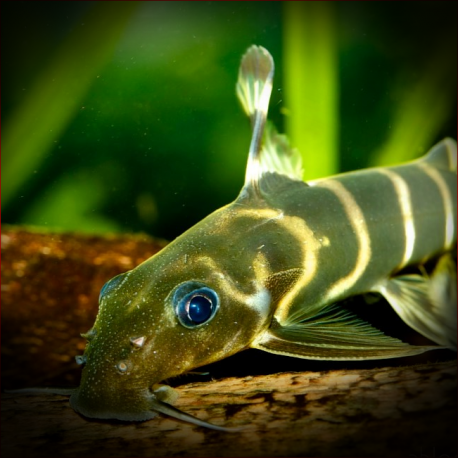More info
Datasheet
| Minimum Tank Size | 110 litres / 29.06 US gallons |
| Maximum Size | 15.0cm / 5.91inches |
| Temperature | 22°C / 71.60°F - 26°C / 78.80°F |
| Hardness | 5-20ºdH |
| pH | 6.2-7.5 |
General Description
An unusual and highly adapted species, the Brichard's Synodontis (Synodontis brichardi) is a favorite among Synodontis enthusiasts, especially when kept in a biotope aquarium that mimics its natural habitat. This species displays vibrant colors which intensify with age and is known to be more diurnal compared to other Synodontis species.
Aquarium Setup
To provide an ideal environment for the Brichard's Synodontis, a tank of at least 110 litres with fine gravel or sand substrate and scattered smooth rocks is recommended. The inclusion of driftwood for shelter is advised, along with strong water flow and efficient aeration. Powerheads can be utilized to maintain adequate water movement, while plants are optional. Algal growth should be encouraged, as this species appreciates areas with high water flow.
Behaviour
The Brichard's Synodontis is a peaceful species but thrives when kept with fish that also prefer flowing, oxygenated water. Ideal tankmates include Steatocranus sp., certain Alestiid tetras, Chaetostoma sp., and some larger characins and barbs. Territorial species, especially other Synodontis, should be avoided in the same tank to prevent potential conflicts.
Feeding and Diet
While dried foods may be accepted, the optimal diet for the Brichard's Synodontis consists of a diverse mix of live and frozen foods supplemented with vegetable matter like blanched spinach, shelled peas, and cucumber. This species has specialized teeth on its lower jaw to rasp at these plant-based foods, contributing to their overall nutrition.
Reproduction & Dimorphism
Although not commonly reported to breed in aquarium settings, the Brichard's Synodontis has been commercially bred in Eastern Europe with the use of hormone injections. In the wild, they are egg scatterers. Sexual dimorphism in this species involves examining the genital papillae, where males have an extended, pointed, and ridged papillae with a visible spermatoduct, while females possess a rounded papillae with the oviduct on the opposite side.
Habitat and Distribution
Native to the Democratic Republic of Congo and the Republic of Congo, the Brichard's Synodontis inhabits areas with turbulent water flow, including rapids and oxygen-rich pools below waterfalls in its natural habitat. It is well-adapted to such environments and displays behaviors reflective of its native surroundings.

